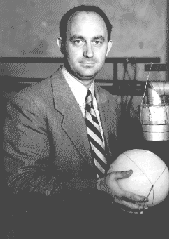 Enrico Fermi
Enrico Fermi Enrico Fermi
Enrico FermiFermi's early work on the statistical distribution of elementary particles led him to divide these atomic constituents into two groups, known as fermions and bosons, depending on their spin characteristics. This division is now accepted as standard. His subsequent work on radioactivity and atomic structure involved experiments on the production of artificial radioactivity by bombarding matter with neutrons, for which he received the 1938 Nobel Prize for physics. In collaboration with other eminent scientists, Fermi experimented with nuclear fission at Columbia University. This work culminated in the first sustained nuclear reaction, on Dec. 2, 1942, at the University of Chicago. Further work at Los Alamos Scientific Laboratory led to the construction of the atomic bomb. After the war, Fermi accepted a post at the newly established Institute for Nuclear Studies at the University of Chicago and continued his work in the field of neutron physics.
